Farmstead-Specific Weather Risk Prediction Technique Based on High-Resolution Weather Grid Distribution
Abstract
:1. Introduction
2. Principles of Crop-Specific Weather Risk Assessment
2.1. Acute Damages
2.2. Chronic Damages
3. Estimating Growth Stages
4. Detailed Farm-Scale Weather Information and Prediction of Agrometeorological Disasters at the Farm Level
5. Conclusions
Author Contributions
Funding
Institutional Review Board Statement
Informed Consent Statement
Data Availability Statement
Acknowledgments
Conflicts of Interest
References
- Gobin, A.; Tarquis, A.M.; Dalezios, N.R. Weather-related hazards and risks in agriculture. Nat. Hazards Earth Syst. Sci. 2013, 13, 2599–2603. [Google Scholar] [CrossRef]
- IPCC. Climate Change 2023: Synthesis Report. Contribution of Working Groups I, II and III to the Sixth Assessment Report of the Intergovernmental Panel on Climate Change; Core Writing Team, Lee, H., Romero, J., Eds.; IPCC: Geneva, Switzerland, 2023; pp. 35–115. [Google Scholar] [CrossRef]
- Yun, J.I. A Feasibility Study of a Field-specific Weather Service for Small-scale Farms in a Topographically Complex Watershed. Korean J. Agric. For. Meteorol. 2015, 17, 317–325, (In Korean with English abstract). [Google Scholar] [CrossRef]
- Kim, D.-J. Past, Present and Future of Geospatial Scheme based on Topo-Climatic Model and Digital Climate Map. Korean J. Agric. For. Meteorol. 2021, 23, 268–279, (In Korean with English abstract). [Google Scholar] [CrossRef]
- WMO. Available online: https://wmo.int/topics/climate (accessed on 1 November 2023).
- Yun, J.I. Agrometeorological Early Warning System: A Service Infrastructure for Climate-Smart Agriculture. Korean J. Agric. For. Meteorol. 2014, 16, 403–417, (In Korean with English abstract). [Google Scholar] [CrossRef]
- UNDRR. Available online: https://www.preventionweb.net/Sendai-Framework/Sendai-Framework-Monitor (accessed on 1 November 2023).
- Wilhite, D.A.; Hayes, M.J.; Knutson, C.; Smith, K.H. Planning for drought: Moving from crisis to risk management. J. Am. Water. Resour. Assoc. 2000, 36, 697–710. [Google Scholar]
- Pearson, L.; Pelling, M. The UN Sendai framework for disaster risk reduction 2015–2030: Negotiation process and prospects for science and practice. J. Extrem. Events 2015, 2, 157001. [Google Scholar] [CrossRef]
- Shim, K.M.; Kim, Y.S.; Jung, M.P.; Choi, I.T.; Kim, H.; Kang, K.K. Implementation of Agrometeorological Early Warning System for Weather Risk Management in South Korea. J. Clim. Chang. Res. 2017, 8, 171–175, (In Korean with English abstract). [Google Scholar] [CrossRef]
- Early Warning Service for Weather Risk Management in Agricultural Sector. Available online: https://agmet.kr (accessed on 1 November 2023).
- Shim, D.; Kwon, M.J.; Hwang, J.G.; Kang, E.-J.; Song, S.-H.; Son, Y.-H.; Kim, J.C.; Cho, K.H.; Im, H.J.; Shim, S.; et al. Effects of Lasting Periods of Low Temperature on the Growth and Physiological Activity in Tea Trees. J. Kor. Tea Soc. 2020, 26, 39–47, (In Korean with English abstract). [Google Scholar] [CrossRef]
- Kim, D.-J.; Kim, J.-H.; Yun, J.I. An Agrometeorological Reference Index for Projecting Weather-Related Crop Risk under Climate Change Scenario. Korean J. Agric. For. Meteorol. 2016, 18, 162–169, (In Korean with English abstract). [Google Scholar] [CrossRef]
- Kim, J.-H.; Kim, D.; Kim, S.; Yun, E.; Ju, O.; Park, J.S.; Shin, Y.S. Estimation of freeze damage risk according to developmental stage of fruit flower buds in spring. Korean J. Agric. For. Meteorol. 2019, 21, 55–64, (In Korean with English abstract). [Google Scholar] [CrossRef]
- Sagong, D.-H.; Kweon, H.-J.; Park, M.-Y.; Song, Y.-Y.; Ryu, S.; Kim, M.-J.; Choi, K.H.; Yoon, T.-M. Impacts of Urban High Temperature Events on Physiology of Apple Trees: A Case Study of ’Fuji’/M.9 Apple Trees in Daegu, Korea. Korean J. Agric. For. Meteorol. 2013, 15, 130–144, (In Korean with English abstract). [Google Scholar] [CrossRef]
- Warrington, I.J.; Fulton, T.A.; Halligan, E.A.; de Silva, H.N. Apple fruit growth and maturity are affected by early season temperatures. J. Am. Soc. Hortic. Sci. 1999, 124, 468–477. [Google Scholar] [CrossRef]
- Yamada, H.; Hamamoto, K.; Sugiura, A.; Tomana, T. Effect of controlled fruit temperature on maturation of apple fruits. J. Japan. Soc. Hort. Sci. 1988, 57, 173–177, (In Japanese with English abstract). [Google Scholar] [CrossRef]
- Parker, J. Seasonal changes in cold resistance and free sugars in some hardwood tree barks. For. Sci. 1963, 8, 225–235. [Google Scholar] [CrossRef]
- NONGSRO (Rural Development Administration). Available online: https://www.nongsaro.go.kr/ (accessed on 1 November 2023).
- Kwon, E.Y.; Jung, J.E.; Chung, U.; Lee, S.J.; Song, G.C.; Choi, D.G.; Yun, J.I. A Thermal Time-Driven Dormancy Index as a Complementary Criterion for Grape Vine Freeze Risk Evaluation. Korean J. Agric. For. Meteorol. 2006, 8, 1–9. Available online: https://koreascience.kr/article/JAKO200617033620816.page (accessed on 1 November 2023). (In Korean with English abstract).
- Cesaraccio, C.; Spano, D.; Snyder, R.L.; Duce, P. Chilling and forcing model to predict bud-burst of crop and forest species. Agric. For. Meteorol. 2004, 126, 1–13. [Google Scholar] [CrossRef]
- Kim, J.H.; Kim, S.O.; Chung, U.; Hwang, K.H.; Kim, J.B.; Yoon, I.K.; Yun, J.I. Geospatial assessment of frost and freeze risk in ‘Changhowon Hwangdo’ peach (Prunus perica) trees as affected by the projected winter warming in South Korea: II. Freezing risk index based on dormancy depth as a proxy for physiological tolerance to freezing temperature. Korean J. Agric. For. Meteorol. 2009, 11, 213–220, (In Korean with English abstract). [Google Scholar] [CrossRef]
- Westeood, M.N. Temperate-Zone Pomology; Physiology and Culture, 3rd ed.; Timber Press Inc.: Portland, OR, USA, 1993; pp. 428–429. Available online: https://books.google.co.kr/books?id=1SojAQAAMAAJ (accessed on 1 November 2023).
- Han, J.H.; Lee, S.H.; Choi, J.J.; Jung, S.B.; Jang, H.I. Estimation of dormancy breaking time by development rate model in ‘Niitaka’ pear (Pyrus pyrifolia Nakai). Korean J. Agric. For. Meteorol. 2008, 10, 58–64, (In Korean with English abstract). [Google Scholar] [CrossRef]
- Kim, D.J. Categorizing Likelihood of Agrometeorological Hazards into Risk Indices. In Proceedings of the 2012 Conference on Korean Society of Agricultural and Forest Meteorology, 2014, Hadong, Republic of Korea, 20 November 2014; pp. 61–73. Available online: https://koreascience.kr/article/CFKO201431262928623.page (accessed on 2 November 2023). (In Korean).
- Kim, S.O.; Kim, D.K.; Choi, Y.J. Forecasting the Likelihood of Chronic Chilling Injury in Crops Based on Daily Temperature Data. In Proceedings of the 2014 Conference on The Korean Society of Agricultural and Forest Meteorology 2014, Hadong, Republic of Korea, 20 November 2014; pp. 222–227. Available online: https://koreascience.kr/article/CFKO201431262928778.page (accessed on 2 November 2023). (In Korean).
- Byun, H.-R.; Wilhite, D.A. Objective Quantification of Drought Severity and Duration. J. Clim. 1999, 12, 2747–2756. [Google Scholar] [CrossRef]
- Kim, D.-J.; Moon, K.-H.; Yun, J.I. Drought Index Development for Agricultural Drought Monitoring in a Catchment. Korean J. Agric. For. Meteorol. 2014, 16, 359–367, (In Korean with English abstract). [Google Scholar] [CrossRef]
- Kim, D.J.; Kim, S.O.; Kim, J.H.; Shim, K.M.; Yun, J.I. A drought index designed for field-scale water management. Asia-Pac. J. Atmos. Sci. 2015, 51, 197–203. [Google Scholar] [CrossRef]
- National Institute of Agricultural Sciences. Technical Guide to Early Warning Service for Agricultural Meteorological Disasters; National Institute of Agricultural Sciences: Wanju, Republic of Korea, 2021; pp. 60–93. Available online: https://books.google.co.kr/books?id=Az2gzwEACAAJ (accessed on 1 November 2023). (In Korean)
- Yun, J.I. Agroclimatic maps augmented by a GIS technology. Korean J. Agric. For. Meteorol. 2010, 12, 63–73, (In Korean with English abstract). [Google Scholar] [CrossRef]
- Korea Rural Economic Institute. Available online: https://www.krei.re.kr/krei/index.do (accessed on 1 November 2023).
- Yun, J.I. Applications of “High Definition Digital Climate Maps” in Restructuring of Korean Agriculture. Korean J. Agric. For. Meteorol. 2007, 9, 1–16, (In Korean with English abstract). [Google Scholar] [CrossRef]
- Kim, S.O.; Yun, J.I. Improving the usage of the Korea Meteorological Administration’s digital forecasts in agriculture: V. Field validation of the sky-condition based lapse rate estimation scheme. Korean J. Agric. For. Meteorol. 2016, 18, 135–142, (In Korean with English abstract). [Google Scholar] [CrossRef]
- Kim, S.O.; Yun, J.I. Improving usage of the Korea Meteorological Administration’s digital forecasts in agriculture: III. Correction for advection effect on determination of daily maximum temperature over sloped surfaces. Korean J. Agric. For. Meteorol. 2014, 16, 297–303, (In Korean with English abstract). [Google Scholar] [CrossRef]
- Yun, E.J.; Kim, S.O. Improving Usage of the Korea Meteorological Administration’s Digital Forecasts in Agriculture: Correction Method for Daytime Hourly Air Temperature over Complex Terrain. Korean J. Agric. For. Meteorol. 2019, 21, 221–228, (In Korean with English abstract). [Google Scholar] [CrossRef]
- Thornton, P.E.; Running, S.W.; White, M.A. Generating surfaces of daily meteorological variables over large regions of complex terrain. J. Hydrol. 1997, 190, 214–251. [Google Scholar] [CrossRef]
- Kim, S.O.; Yun, J.I. A quantification method for the cold pool effect on nocturnal temperature in a closed catchment. Korean J. Agric. For. Meteorol. 2011, 13, 176–184, (In Korean with English abstract). [Google Scholar] [CrossRef]
- Kim, S.O.; Kim, J.H.; Kim, D.J.; Yun, J.I. Wind effect on daily minimum temperature across a cold pooling catchment. Korean J. Agric. For. Meteorol. 2012, 14, 277–282, (In Korean with English abstract). [Google Scholar] [CrossRef]
- Kim, D.-J.; Yun, J.I. Improving Usage of the Korea Meteorological Administration’s Digital Forecasts in Agriculture: 2. Refining the Distribution of Precipitation Amount. Korean J. Agric. For. Meteorol. 2013, 15, 171–177, (In Korean with English abstract). [Google Scholar] [CrossRef]
- Daly, C.; Neilson, R.P.; Phillips, D.L. A statistical topographic model for mapping climatological precipitation over mountainous terrain. J. Appl. Meteorol. Climatol. 1994, 33, 140–158. [Google Scholar] [CrossRef]
- Johnson, G.L.; Pasteries, P.A.; Taylor, G.H.; Daly, C. Spatial climate products—A new dimension for climate applications. In Proceedings of the 11th Conference on Applied Climatology 1999, Dallas, TX, USA, 10–15 January 1999; American Meteorological Society: Boston, MA, USA, 1999; pp. 107–113. Available online: https://ams.confex.com/ams/older/99annual/abstracts/1770.htm (accessed on 1 November 2023).
- Chung, U.-R.; Kim, J.H.; Kim, S.-O.; Choi, M.H.; Hwang, K.H.; Yun, J.I. Geospatial Assessment of Frost and Freeze Risk in ‘Changhowon Hwangdo’ Peach (Prunus persica) Trees as Affected by the Projected Winter Warming in South Korea: II. Freezing Risk Index Based on Dormancy Depth as a Proxy for Physiological Tolerance to Freezing Temperature. Korean J. Agric. For. Meteorol. 2009, 11, 206–212, (In Korean with English abstract). [Google Scholar] [CrossRef]


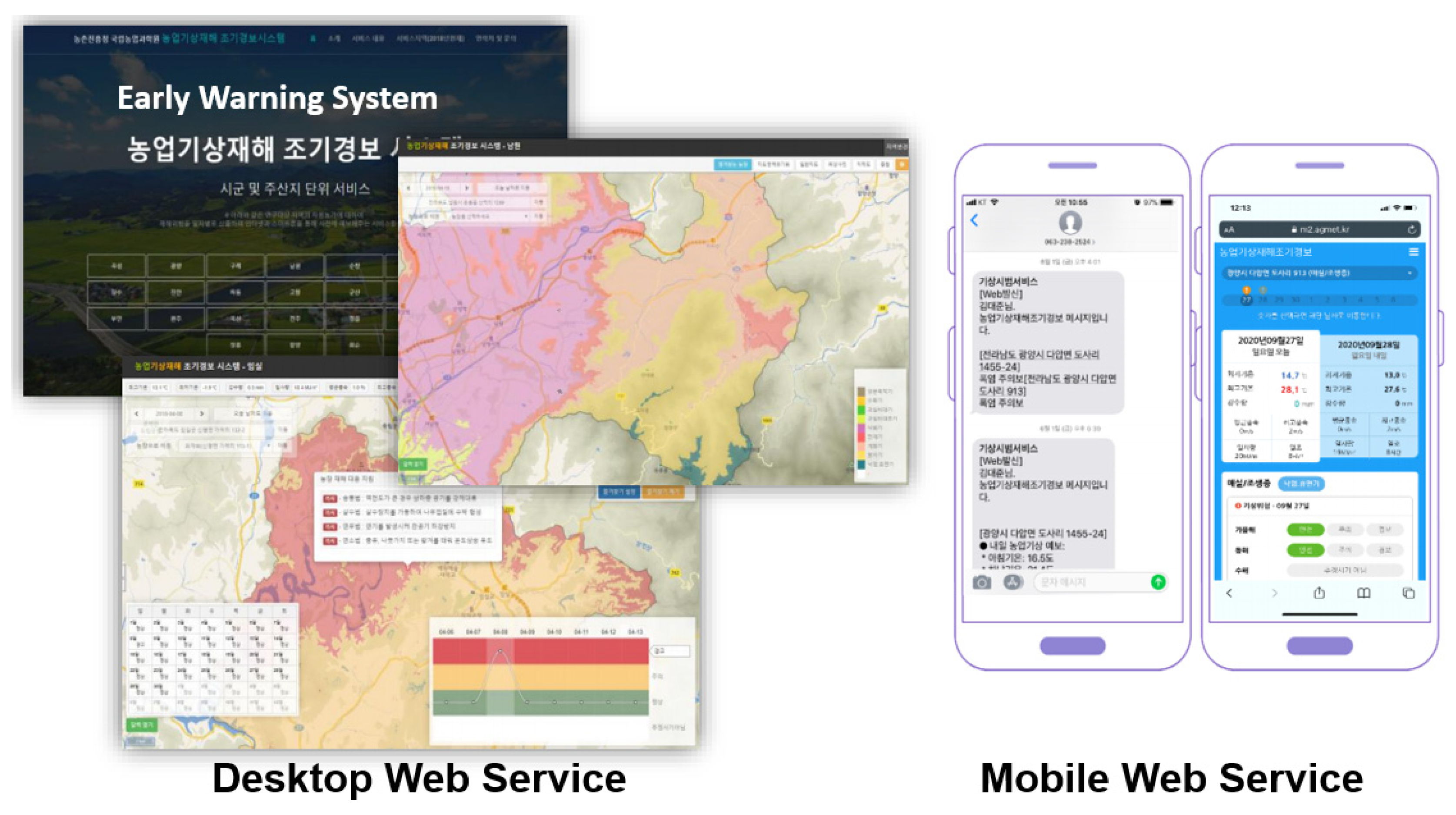

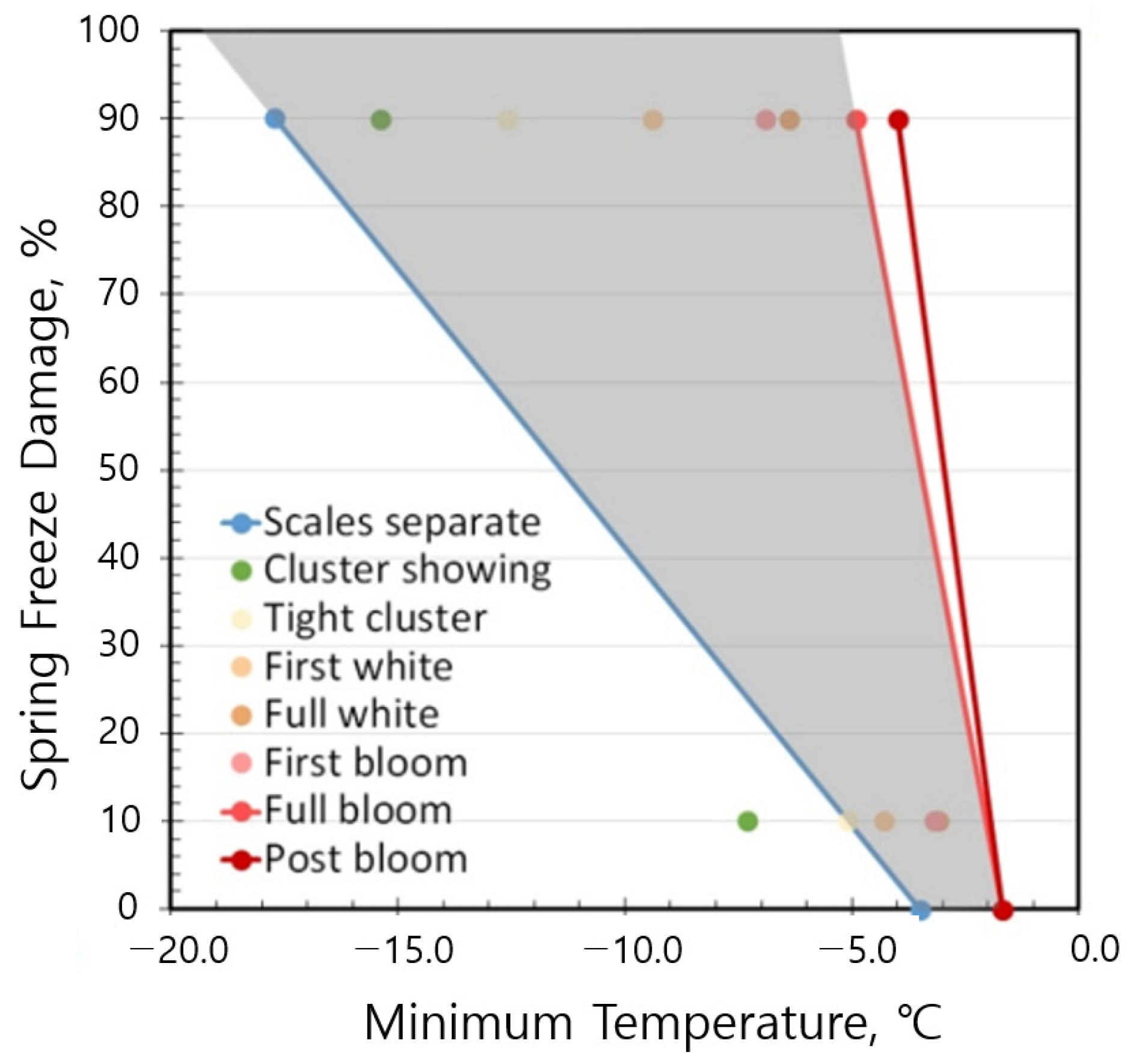
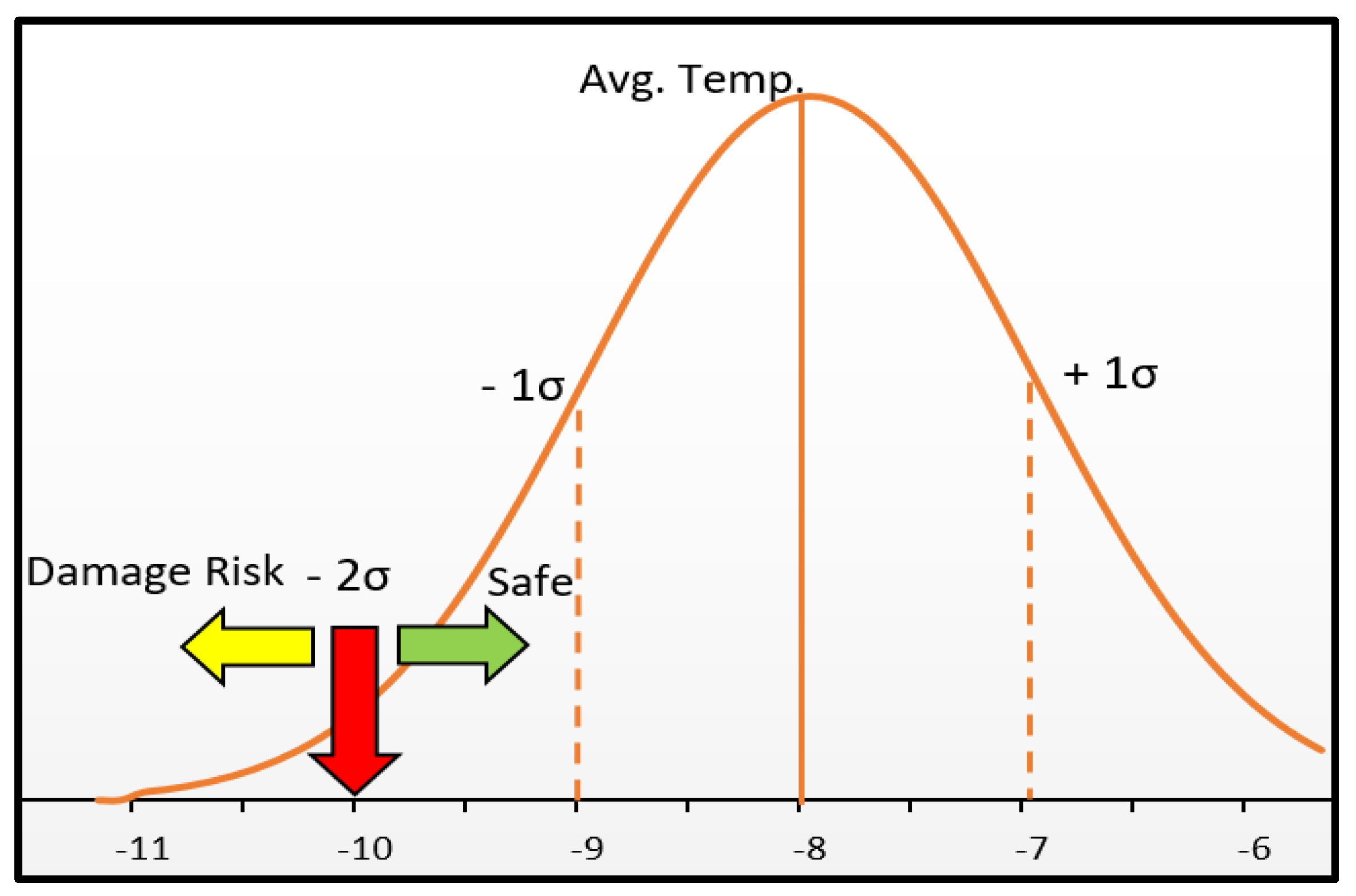
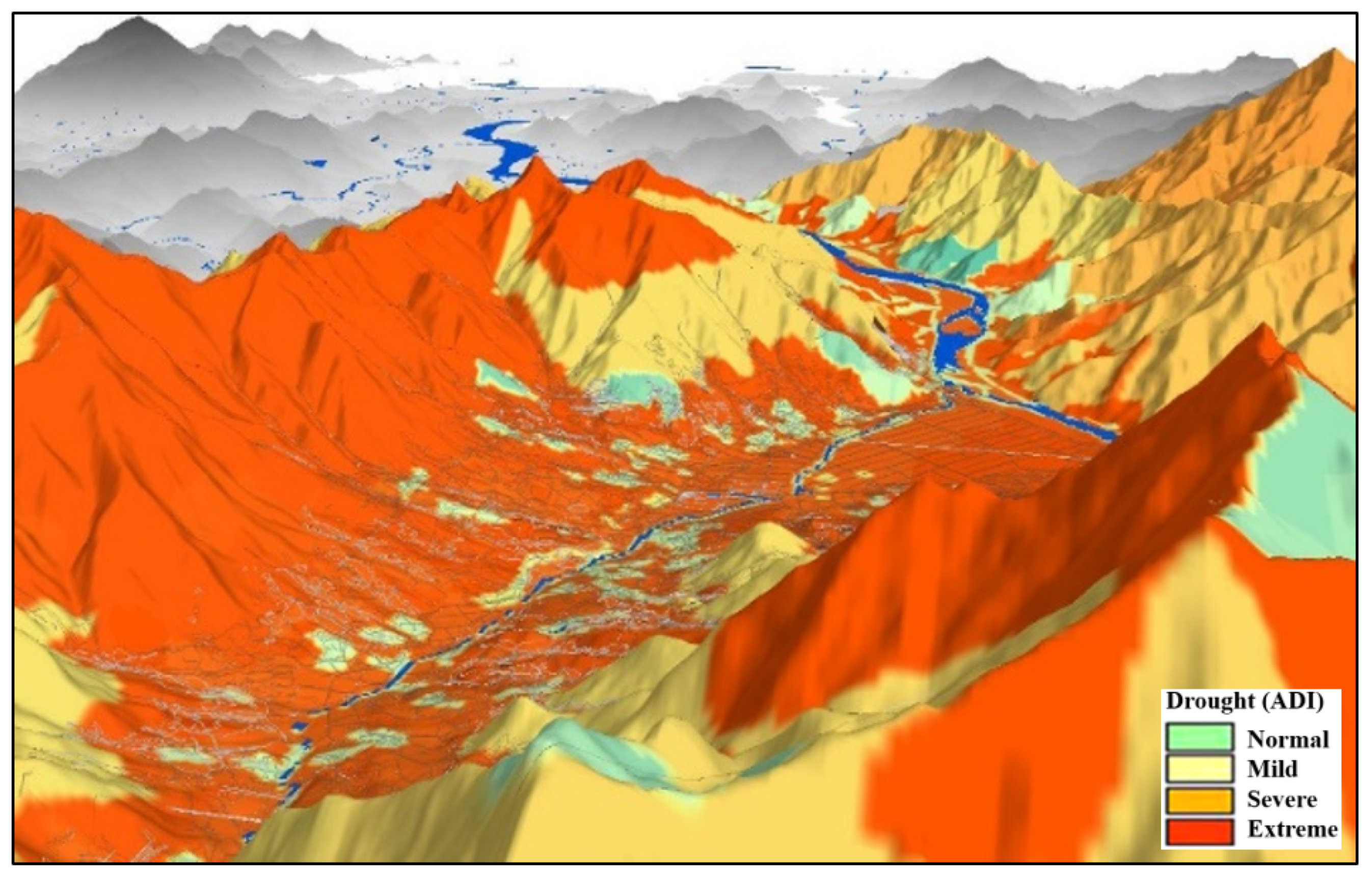

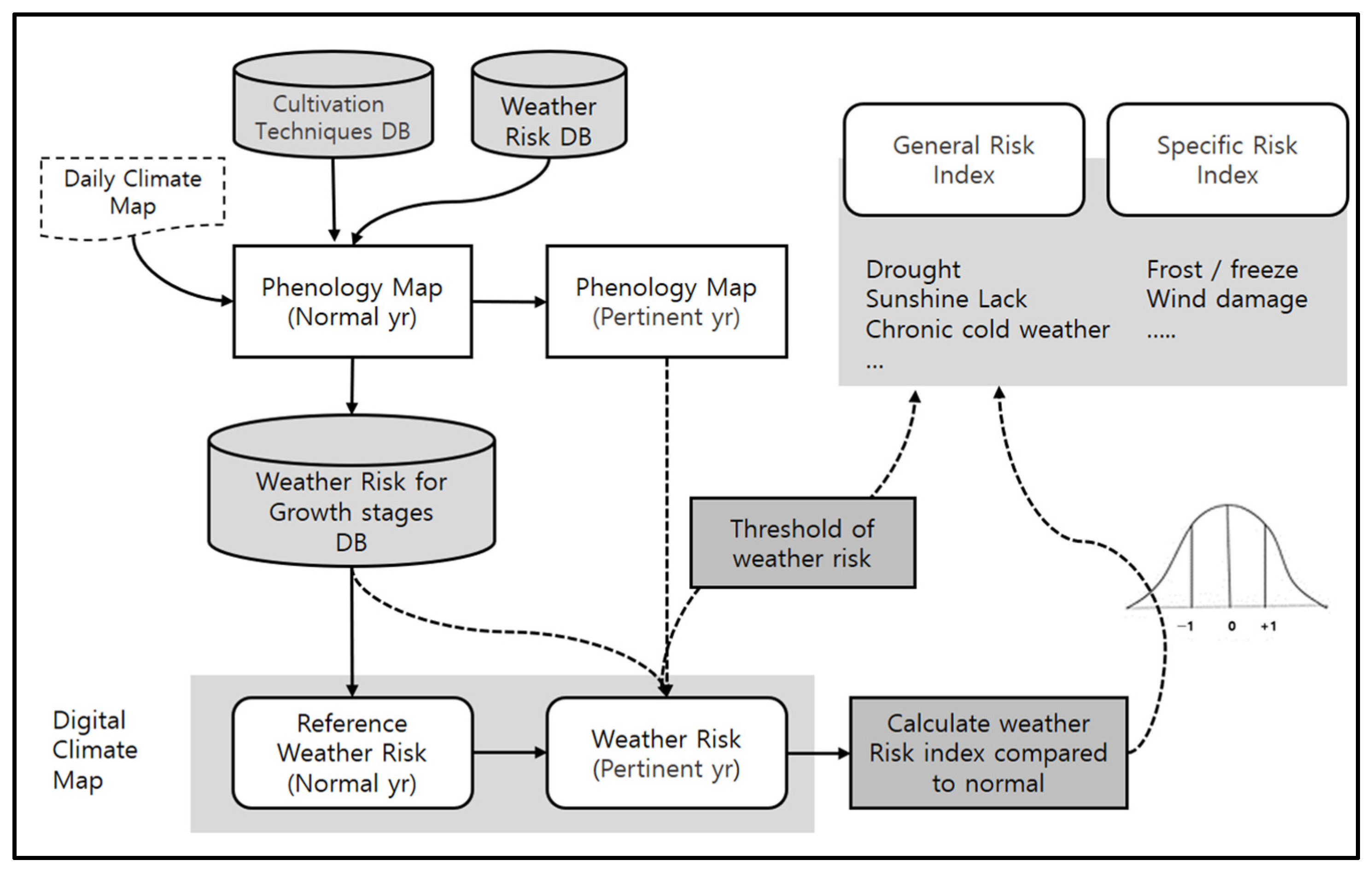

Disclaimer/Publisher’s Note: The statements, opinions and data contained in all publications are solely those of the individual author(s) and contributor(s) and not of MDPI and/or the editor(s). MDPI and/or the editor(s) disclaim responsibility for any injury to people or property resulting from any ideas, methods, instructions or products referred to in the content. |
© 2024 by the authors. Licensee MDPI, Basel, Switzerland. This article is an open access article distributed under the terms and conditions of the Creative Commons Attribution (CC BY) license (https://creativecommons.org/licenses/by/4.0/).
Share and Cite
Kim, D.-J.; Kim, J.-H.; Yun, E.-J.; Kang, D.G.; Ban, E. Farmstead-Specific Weather Risk Prediction Technique Based on High-Resolution Weather Grid Distribution. Atmosphere 2024, 15, 116. https://doi.org/10.3390/atmos15010116
Kim D-J, Kim J-H, Yun E-J, Kang DG, Ban E. Farmstead-Specific Weather Risk Prediction Technique Based on High-Resolution Weather Grid Distribution. Atmosphere. 2024; 15(1):116. https://doi.org/10.3390/atmos15010116
Chicago/Turabian StyleKim, Dae-Jun, Jin-Hee Kim, Eun-Jeong Yun, Dae Gyoon Kang, and Eunhye Ban. 2024. "Farmstead-Specific Weather Risk Prediction Technique Based on High-Resolution Weather Grid Distribution" Atmosphere 15, no. 1: 116. https://doi.org/10.3390/atmos15010116
APA StyleKim, D.-J., Kim, J.-H., Yun, E.-J., Kang, D. G., & Ban, E. (2024). Farmstead-Specific Weather Risk Prediction Technique Based on High-Resolution Weather Grid Distribution. Atmosphere, 15(1), 116. https://doi.org/10.3390/atmos15010116





